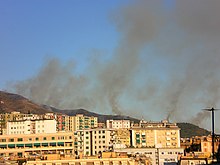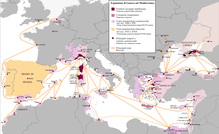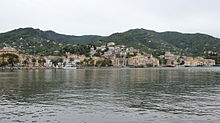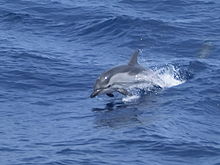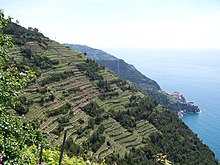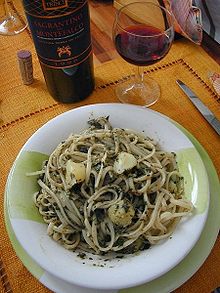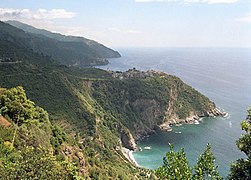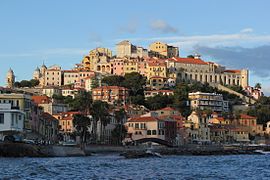Liguria
| Liguria | |
|---|---|
|
|
|
| Basic data | |
| Capital | Genoa |
| Provinces | 4 including metropolitan city of Genoa |
| surface | 5,420.24 km² ( 18th ) |
| Residents | 1,543,127 (Dec. 31, 2019) |
| Population density | 285 inhabitants / km² |
| Website | www.regione.liguria.it |
| ISO 3166-2 | IT-42 |
| president | Giovanni Toti (Cambiamo!) |
 Relief map of the Liguria region |
|
Liguria ( Italian Liguria ) is a coastal region in northwestern Italy with 1,543,127 inhabitants (as of December 31, 2019) and the third smallest Italian region in terms of area . Liguria is bordered to the west by France , to the north by the Region of Piedmont , the east by the Emilia-Romagna and Tuscany and the south by the Ligurian Sea , a part of the Mediterranean . The region belongs to the transnational Euroregion Alpi-Mediterraneo / Alpes-Méditerranée .
The Ligurian region, bounded by the mountain ranges of the Alps and the Apennines in the northeast, is traditionally divided into the Riviera di Ponente and the Riviera di Levante . The border point is the regional capital Genoa .
It was already known as Liguria in the Roman Empire . In the Middle Ages, Liguria was divided into several city- states - the most famous is the Republic of Genoa , which has been able to unite the entire present-day region since the late 14th century. 1797-1815 the area belonged to France , then to Sardinia-Piedmont , which in 1861 rose in the newly founded Kingdom of Italy . Today Liguria is known for tourism (thanks to the Italian Riviera ), its olive oil (made from the Taggiasca olive) and its wine . The " Pesto alla genovese" and the ravioli are well-known representatives of Ligurian cuisine .
The capital of Liguria is Genoa . Other famous cities are Sanremo , La Spezia , Ventimiglia (terminus of many trains from France), Alassio , Imperia ( olive oil production ), Rapallo , Portofino and Savona .
geography
Main article: Geography of Liguria
The region has an area of 5,410 km² and a population of 1.6 million. It extends along the coast of the Ligurian Sea . To the north, it is protected by two mountain ridges that reach the sea: the sometimes Maritime Alps called Ligurian Alps , by the Monte Saccarello , which with 2,201 meters the highest mountain in Liguria, to the Colle di Cadibona rich and the adjoining east Appennino Ligure (" Ligurian " or "Northern Apennines "), which separates the Ligurian coast from the northeastern Po Valley .
Liguria is divided into three provinces and one metropolitan city : (from west to east) Imperia , Savona , Genoa (metropolitan city) and La Spezia . The more than 300 kilometers long coast is divided into the Riviera di Ponente ("setting sun"; western part between Genoa and the French border) and the Riviera di Levante ("rising sun"; eastern part from Genoa to La Spezia). The Riviera di Ponente is divided into the Flower Riviera ( Riviera dei Fiori - from Ventimiglia to Cervo ) and the Palm Riviera ( Riviera delle Palme - from Cervo to behind Savona ).
climate
Liguria has a Mediterranean climate that is not evenly distributed. The climate is influenced by the strong morphological differences in the territory. The Ligurian hinterland is in turn dominated by the strong mountain elevations, while the coastline is dominated by the relatively warm Ligurian Sea.
The arch shape of the region, which opens to the south, and the north-east terminating mountain range, which extends from the French border to Tuscany , are the main factors of the special Ligurian climate. The Apennines in particular act as a watershed between the Mediterranean Sea and the Adriatic Sea , or the Po plain .
When a low pressure area builds up over the Ligurian Gulf in winter , the area around the Ligurian capital is hit by the cool Tramontane wind , which brings rain and snowfall with it. Along the Genoese and Savonese coasts, there is sometimes snowfall at sea level. The summer is moderately warm and humid . For example, at Genoa Sestri in July an average temperature between +20.8 ° C and +27.2 ° C is reached. As a rule, the +30 ° C daytime temperature is only exceeded three to four times in July, but the relative humidity remains high even in the afternoon hours. The heat felt as a result is only mitigated by the sea breeze.
In the interior, the climate is of the harsher semi-continental type. The average temperatures reached in winter are well below those of the coastal zones. Especially the areas facing the Po Valley are characterized by a colder climate. For example, the daily average temperature in Cairo Montenotte in January is +1.8 ° C, in Sassello +1.4 ° C and in Busalla +2.2 ° C. The mean lows in these communities are between −2 ° C and −4 ° C. The general lowest winter temperature is given as −10 ° C, although the temperature can be significantly lower on particularly cold nights. In summer the daytime temperatures are relatively high, but are characterized by significant temperature drops in the nights. The 338 meter high Cairo Montenotte, for example, has the lowest temperature at night in summer with +15 ° C and the highest temperature during the day with +27.7 ° C.
history
Liguria derives its name from its pre-Roman inhabitants, the Ligurians . In the 3rd century BC Chr. The Ligurian coast came under Roman control. The Roman Liguria formed the ninth region under Augustus ' administrative structure and went far beyond today's region by including the northern slopes of the Apennines and the Maritime Alps between Trebia and Po and going beyond Albintimilium (near today's Ventimiglia ). Due to the mountainous and wooded landscape, there were only a few major cities. Dertona was the only colony, and Alba Pompeia , Augusta Bagiennorum (near Bene Vagienna ), Pollentia (part of today's Bra ), Hasta , Aquae Statiellae and Genoa are also worth mentioning. The majority of the Ligurians lived in villages. The division of Augustus remained until Diocletian . Then the two Alpine provinces were abolished and the watershed became the border between Italy and Gaul. The name Liguria was now applied to an area that reached as far as Milan . In the 6th century, Liguria was again separated from Milan, and under the Lombards it formed the fifth Italian province, named Alpes Cottiae .
middle Ages
In the Middle Ages, the part of ancient Liguria north of the Apennines fell to Piedmont and Lombardy , while the southern part with the coastal strip belonged to the Republic of Genoa . For the history in the following centuries see History of Genoa .
politics
The center-left alliance emerged successfully from the regional elections in 2010 with 52.14% of the vote. Claudio Burlando became president of the region . In the elections on May 31, 2015, however, the center-right alliance won, which is mainly due to the success of the Northern League, which won over 20% of the vote. Overall, the center-right alliance has 34.4% of the vote and 16 of the 31 seats, the center-left alliance 27.8% and 8 seats, and the five-star movement 24.8% and 6 seats , other parties got 13% of the vote and no seats in the Ligurian Regional Council . The region's president is Giovanni Toti from the center-right “Cambiamo!” Party.
Administrative division
The territory of the region is divided into three provinces and a metropolitan city with 235 parishes .
| Province or metropolitan city | Capital | ISO | Communities | Population (December 31, 2019) |
Area (km²) | Population density (inh / km²) |
|---|---|---|---|---|---|---|
| Genoa | Genoa | IT-GE | 67 | 835.829 | 1,838.47 | 455 |
| Imperia | Imperia | IT-IM | 67 | 213.919 | 1,156.13 | 185 |
| La Spezia | La Spezia | IT-SP | 32 | 219.196 | 880.87 | 249 |
| Savona | Savona | IT-SV | 69 | 274.183 | 1,544.77 | 177 |
| Liguria | Genoa | IT-42 | 235 | 1,543,127 | 5,420.24 | 285 |
population
Population development

The Ligurian population is largely concentrated in the large and medium-sized coastal towns along the entire Riviera . A not inconsiderable proportion, however, live in the small to medium-sized municipalities inland. This is characterized by a mountainous territory, which offers little settlement space in the narrow valleys. The communities located there are mostly laid out on the hill and mountain slopes and have a few hundred inhabitants. On the other hand, the two valleys open to the sea with the municipalities of Ronco Scrivia and Cairo Montenotte have a slightly higher population density . The latter is the largest city in the Ligurian hinterland. These communities are heavily dependent on the Ligurian coastal centers; Exceptions are some villages that are connected to the Piedmontese cities.
The average age of the population is the highest in Italy. The death rate is well above the birth rate , which has created serious social problems. Even an increased influx of immigrants , which is lower than in the other regions of northern Italy, could not cushion this development. For several years there has been a slight improvement in the situation.
In 2006 there were 12,146 births (7.5 ‰) and 21,092 deaths (13.1 ‰). This results in a natural growth of -8,946 units (-5.6 ‰) compared to the previous year. On December 31, 2006, there were 80,735 foreigners (5.0%) for every 1,607,878 inhabitants . The families consisted of 2.1 people statistically.
| Demographic development in the individual provinces and metropolitan cities in 2006 | |||||
|---|---|---|---|---|---|
| Province or metropolitan city | Births | Deaths | growth | ||
| Genoa | 7.5 ‰ (6623) | 13.3 ‰ (11,755) | -5.8 ‰ (-5132) | ||
| Imperia | 7.8 ‰ (1774) | 12.7 ‰ (2848) | -4.9 ‰ (-1074) | ||
| La Spezia | 7.6 ‰ (1669) | 12.8 ‰ (2836) | -5.3 ‰ (-1167) | ||
| Savona | 7.6 ‰ (2164) | 12.8 ‰ (3634) | -5.2 ‰ (-1470) | ||
In the period after the Second World War , Liguria was characterized by massive immigration, first from southern Italy and later from abroad. Until then, the region had been economically underdeveloped, which led to massive migration to America , especially in the 19th and 20th centuries . For example, Ligurian communities with large populations emerged in Chile and Argentina . The phenomenon of emigration was probably facilitated by the presence of the port of Genoa.
With the economic boom of the post-war period, this trend changed and the region with the port of Genoa developed into a corner of the industrial triangle of northern Italy (together with Turin and Milan ). There was a lot of construction activity along the coast, which affected both nature and the landscape. The symbol of the rapid expansion of the cities is Rapallo , where the uncontrolled expansion of the periphery brought innumerable problems, especially in the traffic-technical sense. The proverbial Rapallizzare (in German: Rapallizare ) derived from this stands for a chaotic and uncontrolled construction today. The regional capital Genoa was also hit by this phenomenon in the sixties and seventies. In this context, the population decline of the last few decades offers the opportunity to reorganize these failed infrastructures.
If in the past the tendency prevailed to leave the small birth villages in order to find work in the large coastal centers of the region, today the trend has changed. Especially in the big cities of Western Liguria, more and more families are moving to the surrounding communities.
crime
The data of the Italian Ministry of the Interior from 2008 put the Ligurian capital Genoa in fifth place in the crime statistics. Although the total number of crimes had decreased by 16.9% compared to the previous year, there were still 6,592 crimes per 100,000 inhabitants in Genoa. Imperia ranks eighth with 5786 crimes per 100,000 inhabitants. Genoa also has the Italian crime statistics for pickpockets (633 thefts per 100,000 inhabitants). Savona ranks fourth in national statistics with 243 cases of fraud per 100,000 inhabitants.
nature
The region is rich in natural resources and offers a wide range of ecosystems through the connection of land and sea . On the territory of Liguria there is a national park , eight regional parks, three regional nature reserves and one national nature reserve and finally 19 Comunità Montane . A total of 12% of the Ligurian territory, i.e. around 60,000 hectares, is under special nature protection.
The Ligurian High Trail (Italian: Alta Via dei Monti Liguri (AVML) ), a 440-kilometer hiking trail , connects Ventimiglia near the border with Ceparana on the border with Tuscany. The path, which mostly runs on the ridges of the Ligurian Apennines, crosses a large number of the above-mentioned nature reserves.
With two marine reserves and the sanctuary of the whales , certain sections of the Ligurian Sea are protected. The whale sanctuary covers an area of 87,000 square kilometers between the French Côte d'Azur , Sardinia and the Italian regions of Liguria and Tuscany .
flora
About 69% of the land area of Liguria is forested . This means that the region has the largest forest area in Italy in relation to its extent (the national average is around 21%). This also makes Liguria particularly vulnerable to forest fires , around 71% of which are caused by arson .
The largest forest areas are in the Ligurian interior. A special feature of the territory are the wide beech forests that have developed on the rainy mountain sides of the Apennines . Large beech forests grow particularly in the Val di Vara and on Monte Gottero . The communal forests on Monte Penna and in the Agoraie , which are part of the Aveto Natural Park , are characterized by beech and silver fir . This mixed forest type is characteristic of the ancient forests of the Ligurian Apennines.
The alpine forests of the Alta Val Tanarello , near Imperia , consist of Scots pines and beeches in the lower altitudes . There are numerous larches on the slopes of Monte Saccarello .
The Ligurian flora is typical of the Mediterranean vegetation . In the mountain areas in the west of the region, however, there are also alpine influences, so that the flora there is similar to that of the Pyrenees and Provence . The artificially settled species include the olive tree , chestnut and pine tree . On the slopes facing the sea there are mainly vine, olive and fruit crops . In the coastal plains, citrus fruits , especially lemons , are occasionally grown. The Riviera of Flowers , on the other hand, is known for its ornamental plant production, which is the most important industry there.
The maquis dominating the coast consists of gorse ( Genista ), the holly buckthorn ( Rhamnus alaternus ), the mastic bush ( Pistacia lentiscus ), the myrtle ( Myrtus communis ), the western strawberry tree ( Arbutus unedo ) and the holm oak ( Quercus ilex ). In the past, the latter inhabited large areas of Liguria up to an altitude of 600–700 meters. Oleaster ( Olea europaea subsp. Sylvestris ), carob tree ( Ceratonia siliqua ) and tree spurge ( Euphorbia dendroides ) are less common and restricted to warmer and drier areas . Wild herbs are thyme and rosemary . In addition, the real laurel ( Laurus nobilis ) grows on Ligurian territory . In the barren, wind-exposed zones, mostly low, woody bushes have managed to settle. Pine trees such as maritime pine ( Pinus pinaster ) and, more rarely, Aleppo pine ( Pinus halepensis ) grow on the coast and in the adjacent hill zone .
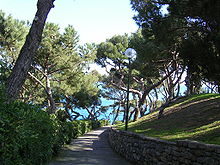
In the altitude between the middle hill zone and the mountains, there are large coniferous forests . These forests, consisting mostly of black pine ( Pinus nigra ) and Norway spruce ( Picea abies ), are of human origin. The tree species that are not part of the original Ligurian flora were introduced by forestry because of their ease of cultivation and the good quality of wood. Although they are relatively widespread, they have difficulties adapting to the humid and changeable climate of the region.
Another case of artificial distribution is the maritime pine in the hilly areas and the larch in the alpine zones, which, although they are part of the original Ligurian vegetation, are favored by selective felling and are therefore much more widespread than their actual climax conditions would allow. The optimal and original vegetation area for the maritime pine is the sub-Mediterranean hill zone with acidic soils and the subalpine plains of the Ligurian Alps with southern exposure for the larch. This development has put many forest ecosystems in the mountain regions at great risk .
Various trees were planted for decorative purposes in the tourist areas along the coast in the 20th century. This is especially true of the numerous palm species that were imported from North Africa and the subtropical zones of North America , East Asia and Oceania and that now adorn the Palm Riviera . The magnolias , on the other hand, come from Asia and are now used in many gardens on the coast.
In some cases, the Ligurian climate has given introduced plant species a selection advantage over the original vegetation. One example of this is the Hanbury Botanical Gardens near Ventimiglia , which were laid out in the 19th century by the English family of the same name. Originally 5800 plant species were cultivated in the gardens, of which around 2000 are still present today. Among the palm trees that flank numerous promenades today, the Canary Island date palm ( Phoenix canariensis ) and the real date palm ( Phoenix dactylifera ) are the most common .
fauna

The overall picture of the animal world is typical of the Mediterranean region and is strongly influenced by its proximity to French Provence and Tuscany . Animals of more distant origins can also be found in Liguria, such as from Morocco , Sardinia or Corsica . This phenomenon reflects the historical connection with these zones.
The animal species that occur in the Riviera di Ponente include the European lizard snake , which occurs in the zone between Imperia and Nice , and the largest European lizard species, the pearl lizard . In the hinterland of Ventimiglia, however, there is a constant population of Bankiva chickens and some chamois live on the steep slopes of Monte Toraggio . Marmots can also be found on Monte Saccarello between Liguria and France .
The special features of birds include Blue Merle , the Sardinian Warbler , the white beard warbler , the woodpecker , the wryneck , the cuckoo and thrush . Birds that are particularly common are the blackbird , the chaffinch , the bunting and the robin .
Nocturnal and diurnal birds of prey are particularly widespread in the region. Nocturnal owls include the scops owl , the little owl , the barn owl , the tawny owl , the long-eared owl and the eagle owl . Short-toed eagles , buzzards , kestrels , black kites and honey buzzards can be observed during the day. The nesting of a few specimens of the golden eagle and the peregrine falcon on the rocks of the Ligurian Levant has been documented. In the dense forests, however, hawks and sparrowhawks can be found.
Among the reptiles , the yellow-green angry snake , the Girondic smooth snake and several types of vipers are common. Above an altitude of 1800 meters of the triggers amphibians scoring Alpine salamander his relatives, the widespread salamander from. They prefer to live in the caves of the Ligurian hinterland.
In the past, Liguria was populated by numerous packs of wolves. Today, however, only a few wolves still live in the remote mountainous areas of the region. The lack of natural enemies, on the other hand, has caused the wild boar population to increase dramatically. In search of food, these invade the residential areas, where they devastate plantations and gardens. The situation in the Portofino zone is particularly tense . In Val Polcevera and in the neighborhoods close to the center of Genoa whole boar families were seen.
National and regional nature parks
Nature reserves
In the western section of the Ligurian Riviera, and especially in the province of Savona , there are three nature reserves . The Riserva di Bergeggi includes the eight hectare large island Bergeggi with its entire surface. The island, consisting of limestone rocks , is covered in Mediterranean macch and serves as a nesting site for a colony of Mediterranean seagulls. In addition to the island, the reserve also includes the rocky coast between the villages of Bergeggi and Spotorno , with a grotto that can only be reached from the sea . The 11 hectare island of Gallinara has also been designated a nature reserve, the Riserva dell'Isola Gallinara . It is also overgrown with maquis. However, the monotony of the vegetation is interrupted by the blossoms of numerous roses ( Rosa gallinariae ) and the Centaura aploepa . The Riserva di Rio Torsero has an area of around four hectares and contains various fossils from the Pliocene . The remains of various molluscs were found in the rocks of the nature reserve , which are now exhibited in the Peagna Museum in Ceriale . The territory of the reserve is rocky and calcareous and is also overgrown with maquis.
In the Levante Liguria there is a nature reserve in the metropolitan city of Genoa . The Riserva naturale statale Agoraie di Sopra e Moggetto is located within the Aveto Natural Park at an altitude of 1330 meters. It is 16 hectares and is dominated by four lakes, which belong to the Agoraie di Sopra group of lakes . The vegetation consists of beech and fir trees , which benefit from a cool, humid climate. Various amphibian species live in the reserve , such as the northern crested newt ( Triturus cristatus ) and the common frog ( Rana temporaria ).
Marine protected areas
There are two marine protected areas in Liguria, one in the province of La Spezia and the other in the metropolitan city of Genoa:
- Cinque Terre Marine Protected Area : it covers 4591 hectares and is bordered by Punta Mesco and Riomaggiore . The protected coastline is divided into three protection zones (A, B and C). Characteristic are the overhanging rock walls and the rocky seabed , which is repeatedly interrupted by sand-covered zones. Various colonies of gorgonians , sea anemones and corals live in the protection zone . Neptune grasses ( Posidonia oceanica ) occur in the sandy seabed .
- Marine reserve Portofino : 372 hectares of the sea area around the Portofino peninsula are under protection and include both parts of the Golfo Paradiso and the Golfo del Tigullio . Gorgonians, precious corals and sponges predominate in the marine flora , as do the Neptune grasses mentioned above on a sandy bottom.
In addition, the Ligurian Sea is part of the whale sanctuary .
economy
Economic data
In comparison with the gross domestic product (GDP) of the EU expressed in purchasing power standards, Liguria achieved an index of 107 (EU-28: 100) (2015). With a value of 0.896, Liguria ranks 7th among the 21 regions and autonomous provinces of Italy in the Human Development Index . In 2017, the unemployment rate was 9.5%, making it the highest in northern Italy.
The economy of Liguria is specialized in a few production areas within the three main economic sectors (primary to tertiary), which in turn are strongly interdependent. In the primary sector, the production of certified, regionally typical agricultural products stands out. There is fishing along the coast and cattle breeding in the Ligurian interior .
The industry is mainly located in the outskirts of the major urban centers, such as the provincial capitals Imperia, Savona, Genoa and La Spezia. The ports of Genoa, La Spezia and Savona were and are decisive for the development of the Ligurian industry. In this context, maritime trade , shipbuilding and tourism should be mentioned. Secondary to this, the steel , chemical , petrochemical and metal processing industries developed in the raw materials sector .
The following shows the development of gross domestic product (Italian: PIL ) and gross domestic product per capita ( PIL procapite ).
| 2000 | 2001 | 2002 | 2003 | 2004 | 2005 | 2006 | |
|---|---|---|---|---|---|---|---|
|
Gross domestic product (in million euros) |
33,669.8 | 35,534.7 | 36,053.6 | 37,218.6 | 38,644.1 | 39,913.5 | 41,004.5 |
|
Gross domestic product per capita (in euros) |
21,264.2 | 22,568.9 | 22,948.0 | 23,633.8 | 24,382.7 | 24,927.3 | 25,484.5 |
Below is the breakdown of the GDP produced in Liguria by main industry in million euros. The market prices from 2006 apply as reference.
| Main industry | gross domestic product | Percentage of regional GDP | Percentage of national GDP |
| Agriculture, forestry , fishing | € 611.9 | 1.49% | 1.84% |
| Industry in the strict sense | € 4,030.7 | 9.83% | 18.30% |
| Construction industry | € 2,261.8 | 5.52% | 5.41% |
| Commerce , restoration and repair, hotel and catering, transport and communication | € 10,285.0 | 25.08% | 20.54% |
| Financial services , real estate trading and business consulting | € 10,898.9 | 26.58% | 24.17% |
| Other service industries | € 8,512.1 | 20.76% | 18.97% |
| Value Added Tax (IVA), indirect product taxes and import taxes | € 4,404.2 | 10.74% | 10.76% |
| Italy's GDP at market price | € 41,004.5 |
The comparison of the regional with the national economic data shows that the economy of Liguria is in a post-industrial phase, whereby the industrial share in the total economy of Liguria is only half of the Italian share. In the past few decades the economic focus has shifted to the areas of services, trade and tourism.
Agriculture
Agriculture in Liguria is strongly influenced by the morphology of the territory, which with its narrow coastline and mountainous hinterland offers little space for cultivation. The Cinque Terre provide a characteristic picture , where numerous terraces were created with the help of dry stone walls , which are used for plant cultivation.
Primarily fruits , olives and ornamental plants are cultivated in Liguria . In the Riviera di Ponente in particular, around half of Italian flower production takes place. That is why the A10 motorway is also known as the “motorway of flowers”.
Agriculture consists on the one hand of traditional fruit and vegetable cultivation, on the other hand of olive cultures (concentrated around Leivi , Lavagna and Sestri Levante ), orchards ( lemon , peach and apricot ) and viticulture ( Moscato Bianco , Ciliegiolo , Bianchetta Genovese and Vermentino ). Most of the vineyards are located in the area surrounding La Spezia , where the red grape varieties Sangiovese , Ciliegiolo and Canaiolo , as well as the white grape varieties Bosco , Albarola , Trebbiano and Vermentino are grown.
From an agricultural point of view, the Val di Vara is a specialty . Here organic cultivation is so pronounced that the valley was given the nickname “Valle del Biologico”. Its main branches of agriculture are the livestock , the dairy industry and the beef meat production .
tourism
Tourism is an important source of income for Liguria. The mild climate, the renowned towns such as Portofino , the Cinque Terre or Porto Venere and the diversity of leisure activities attract tourists from home and abroad.
The focus in the summer months is on beach and bathing holidays. In addition, regardless of the season, fishing tourism and agrotourism also play a role. In terms of culture, a large number of exhibitions , congresses , festivals and celebrations take place in Liguria . In addition, the numerous medieval fortresses and historically significant places can be visited.
However, mass tourism has also created significant environmental problems. Long stretches of coast were cemented, a phenomenon that the Ligurians named Rapallizzazione , after the traditional tourist destination Rapallo . The geomorphologically already very limited open space was further reduced by the extensive bathing and leisure buildings; this prevents an expansion of the ports. The low population also makes the economic upswing difficult. Although the region has a larger rich population, the region and the Italian state are losing much of their capital through tax evasion to nearby Monaco .
traffic
Roads and highways

The motorways that cross the region or connect them to the neighboring states and regions are as follows:
- A6 motorway : Also known as VerdeMare or popularly known as the motorway of death because of the high accident rate in the winding section between Ceva and Savona . It connects Savona with Turin .
- A7 motorway : it connects Milan with Genoa.
- Autobahn A10 : Also called the Autobahn of Flowers . It crosses the entire Riviera di Ponente and connects Genoa with Ventimiglia.
- A12 motorway : also known as the Autostrada Azzurra . It runs along the Tyrrhenian Sea and connects Genoa with Livorno .
- A15 Motorway : Also known as the Autocamionale della Cisa . It connects La Spezia with Parma by crossing the Valle del Taro , Lunigiana and the Val di Magra .
- A26 motorway : Also known as the tunnel motorway . It runs from Genoa, in the Voltri district , over the Apennines (pass crossing at Passo del Turchino ), past Ovada and finally joins the A21 near Alessandria .
Rail connections

The rail network is strongly influenced by the morphology of the region. The impassability of the Ligurian hinterland has led to the concentration of almost all rail traffic along the coast. Exceptions are some supra-regional connections. The Ligurian railway lines are:
- Genoa – Ventimiglia railway line : runs, partly single-track, along the coast of the Riviera di Ponente and connects the regional capital with Savona, Imperia and Ventimiglia; there are also international connections to France
- Genoa – La Spezia railway line : runs along the coast of the Riviera di Levante and connects to Tuscan railway lines
- Genoa – Ovada – Acqui Terme railway line
- Genoa – Milan railway line
- Turin – Genoa railway line
- Savona – Turin railway line
- Savona – Acqui Terme railway line
- Pontremolese railway line : connects Parma to the Tyrrhenian rail network at La Spezia
- Railway line Cuneo – Limone – Ventimiglia (also Tendabahn): runs partly on French territory
- Genoa – Casella railway : a narrow-gauge railway to Casella
Airports
The main airport in the region is the Cristoforo Colombo International Airport near Sestri Ponente . This is located about nine kilometers west of the Genoese city center, with which it is connected via the A10. The airport was inaugurated in 1962 on a raised peninsula in the Gulf of Genoa. It has a 3,065 meter runway and an airport building that was only completed in 1986.
Occasionally it is used as an alternative object by the major airports in Northern Italy when they are closed due to fog . The Genoese airport is of great importance for the port of Genoa, as well as for the industry and the city's trade fair .
Smaller airports are at Albenga ( Clemente Panero International Airport ) and Luni (Bartolomeo Arrigoni Airport). The latter serves mainly as a base for the Italian Navy .
Culture
language
Official and common language is Italian . The regional language Ligurian is one of the Galloital varieties and is used in the region itself, but also in the bordering zones of Piedmont and Emilia-Romagna , on the Sardinian islands of San Pietro and Sant'Antioco and in the municipalities of Bonifacio and Calvi on Corsica spoken. Although the language has become less and less spoken over time, it has seen some resurgence in recent decades. This has its starting point in the rediscovery of Ligurian in literature and especially in music. Well-known representatives of this trend include Gilberto Govi , the music group Buio Pesto and Fabrizio de André .
Curiously, the term Ligurian or Liguria does not exist in the Ligurian language, which is due to the dominance of the Republic of Genoa . This is how people spoke of the Genoese language , even in places far away from the capital .
kitchen
The Ligurian cuisine is typical of the Mediterranean cuisine , the products of fishing with the products of agriculture combined. The dishes are characterized by their simplicity and are seasoned with numerous herbs, such as rosemary and thyme . The latter grow wild all over the territory and are typical representatives of the Mediterranean maquis .
The most famous regional product is certainly olive oil , which forms the basis of most dishes in Ligurian gastronomy . The most important dishes typical of the region include the various fish dishes, the focaccia , the pesto , the farinata and the trofie . Pandolce stands out among the desserts .
Personalities
The following famous personalities were born in the Liguria region: the actors Paolo Villaggio , Vittorio Gassman and Giancarlo Giannini , the director Pietro Germi , the musicians Niccolò Paganini and Luciano Berio , the songwriters Fabrizio de André , Max Manfredi and Umberto Bindi , the scientist Giulio Natta , the writers Edmondo De Amicis , Eugenio Montale , Edoardo Sanguineti , the critic Carlo Bo , the politicians Palmiro Togliatti , Alessandro Natta , Sandro Pertini , the architect Renzo Piano and the tennis player Fabio Fognini .
The Ligurians Christopher Columbus , Giuseppe Garibaldi , Goffredo Mameli , Giuseppe Mazzini , Andrea Doria are of historical importance .
Sports
In addition to football , water polo is very popular in Liguria . In this area, the teams Pro Recco , Rari Nantes Savona , Rari Nantes Camogli , Rari Nantes Bogliasco and Rari Nantes Sori are important .
In Basketball is Basket Spezia Club successful. The women's team plays in Serie A1.
Soccer
In professional football, the two Genoese football clubs Genoa and Sampdoria are of national importance. Both play mostly in Serie A and host the legendary Derby della Lanterna .
Numerous other soccer teams play in the amateur class. In series D , the Unione Sportiva Dilettantistica Lavagnese 1919 ( Lavagna ), the Associazione Sportiva Dilettantistica Sarzanese Calcio 1906 ( Sarzana ), the Associazione Sportiva Dilettantistica Savona 1907 Foot-Ball Club ( Savona ), the Fratellanza Sportiva Sestrese Calcio 1919 ( Sestri Ponente ) , the Unione Sportiva Sestri Levante ( Sestri Levante ), the Associazione Sportiva Dilettantistica Spezia Calcio 2008 ( La Spezia ) and the Associazione Calcio Dilettantistica Virtus Entella ( Chiavari ).
gallery
Piazza de Ferrari in the center of Genoa
Ligurian coast as seen from Deiva Marina / Framura .
Coast of Corniglia in the "Cinque Terre"
The town of Vernazza in the " Cinque Terre "
Groppo Rosso near Santo Stefano d'Aveto
Porto Maurizio in Imperia on the Riviera di Ponente
See also
- List of municipalities in Liguria
- List of museums in Liguria
- List of coats of arms in Liguria
- Euroregion Alpi-Mediterraneo / Alpes-Méditerranée
Web links
Individual evidence
- ↑ Statistiche demografiche ISTAT. Monthly population statistics of the Istituto Nazionale di Statistica , as of December 31 of 2019.
- ^ Ministry of the Interior ( Memento from March 31, 2010 in the Internet Archive )
- ↑ ISTAT - Demography 2006
- ↑ Italia, reati in calo dell'8.1% - Ma Genova è quinta assoluta
- ↑ Emergenza Cinghiale a Genova at Repubblica.it.
- ↑ Eurostat. Retrieved April 15, 2018 .
- ^ Sub-national HDI - Area Database - Global Data Lab. Retrieved August 12, 2018 .
- ↑ Unemployment rate, by NUTS 2 regions. Retrieved November 5, 2018 .
- ↑ a b data ISTAT - 2008 ( Memento from March 21, 2008 in the Internet Archive )
Coordinates: 44 ° 27 ' N , 8 ° 46' E




